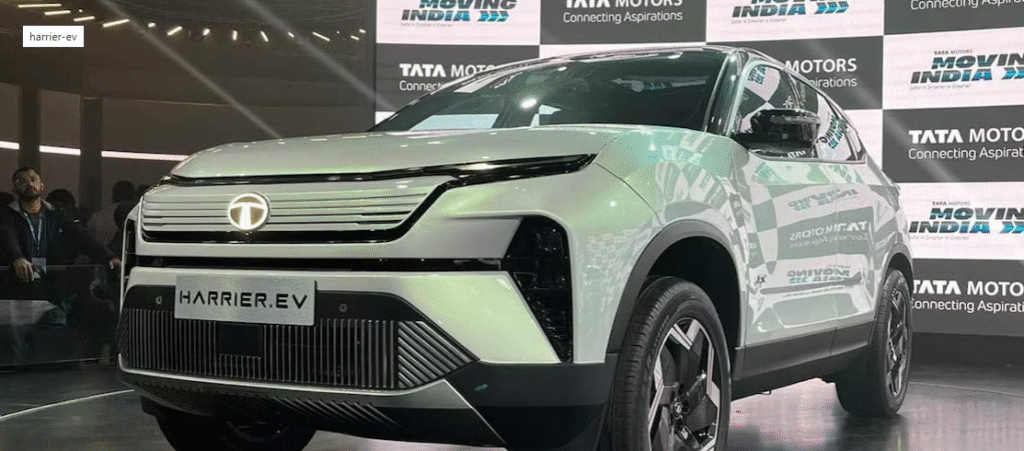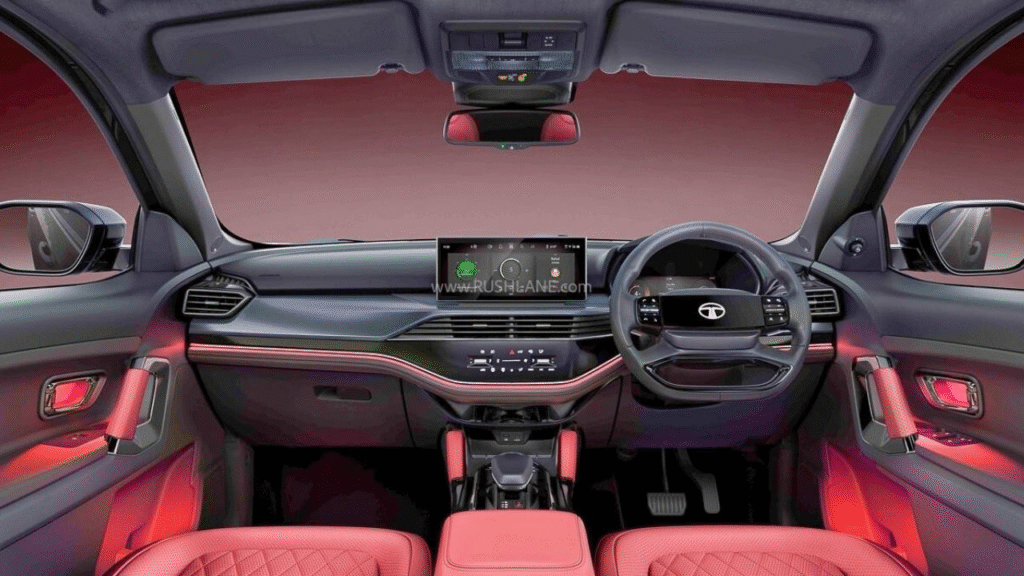Tata Motors Shifts Gears: Harrier EV Steals the Spotlight


Tata Motors, a titan of India’s automotive industry, has once again redefined the road ahead with the launch of the Harrier EV on June 3, 2025. Priced at an introductory ₹21.49 lakh (ex-showroom), this all-electric SUV marks a bold leap in Tata’s electric vehicle (EV) journey, blending premium design, cutting-edge technology, and eco-conscious performance. As the flagship of Tata’s expanding EV lineup, the Harrier EV has ignited excitement, promising to challenge rivals and reshape the premium SUV segment in India. Here’s a deep dive into how Tata Motors is shifting gears and why the Harrier EV is stealing the spotlight.
A New Chapter in Tata’s EV Legacy
Tata Motors has long been a pioneer, from launching the iconic Sierra in the 1990s to dominating India’s EV market with models like the Nexon EV and Punch EV. The Harrier EV, built on the advanced Active Gen 2 platform, joins a robust lineup that now includes six electric offerings: Tiago EV, Tigor EV, Punch EV, Nexon EV, Curve EV, and the Harrier EV itself. This launch underscores Tata’s ambition to capture a 50% share of India’s EV market, targeting a diverse audience—from daily commuters to adventure enthusiasts—in a segment where SUVs now account for over half of passenger vehicle sales.
Power and Performance: Electrifying the Drive
The Harrier EV delivers a jolt of innovation with two battery options: a 65 kWh pack for rear-wheel-drive (RWD) variants, producing 235 bhp, and a 75 kWh pack for dual-motor, quad-wheel-drive (QWD) setups, unleashing a combined 313 bhp and 504 Nm of torque. The top-spec model rockets from 0 to 100 km/h in a thrilling 6.3 seconds, outpacing many internal combustion engine (ICE) rivals that typically offer around 350 Nm. Tata claims a MIDC-certified range of up to 627 km for the 75 kWh variant, with real-world estimates of 480–505 km for RWD models—perfect for long hauls across India’s diverse terrain.

Charging is equally impressive: a 120 kW DC fast charger juices the battery from 20% to 80% in just 25 minutes, adding 250 km of range in a mere 15 minutes. A 7.2 kW AC charger takes 10.7 hours for a full charge, and features like vehicle-to-load (V2L) and vehicle-to-vehicle (V2V) charging enhance practicality. Six terrain modes—Normal, Grass/Snow, Mud ruts/Gravel, Sand, Rock Crawl, and a configurable option—paired with Drift and Boost modes, make the QWD variant a trailblazer, marking Tata’s first all-wheel-drive offering since the Safari Strome.
Design: Bold Yet Familiar

Visually, the Harrier EV echoes its diesel-powered sibling, the Harrier, with a sleek silhouette and rugged appeal. EV-specific tweaks set it apart: a blanked-off grille with horizontal creases, connected LED DRLs with welcome/goodbye animations, and a tweaked bumper with vertical slats scream modernity. The side profile boasts 19-inch dual-tone alloy wheels with aerodynamic covers, black cladding, and matching ORVMs. Available in four colors—Nainital Nocturne, Empowered Oxide, Pure Grey, and Pristine White—plus an exclusive matte Stealth Edition, the Harrier EV blends style and substance.
Inside, the cabin elevates luxury with leatherette seats, a dual-tone leatherette steering wheel with an illuminated Tata logo, and a premium feel. A 14.53-inch cinematic infotainment display, powered by Samsung’s Neo QLED technology—a global first for automotive use—pairs with a 10.25-inch digital driver’s display. A JBL Black 10-speaker system with Dolby Atmos, wireless Android Auto and Apple CarPlay, dual-zone climate control, and a voice-assisted sunroof round out the tech-heavy interior.
Safety and Innovation: Redefining Standards
Safety is paramount, with the Harrier EV boasting a Level 2 ADAS suite tailored for Indian roads, featuring 22 advanced functions like adaptive cruise control and intelligent speed assistance. A segment-first 540-degree surround view system, including a Transparent Mode to reveal terrain beneath, aids off-road adventures. Up to seven airbags, front and rear parking sensors, and a robust Active Plus platform—rooted in Jaguar Land Rover’s D8-based OMEGA architecture—ensure peace of mind. Tata sets a new benchmark with a lifetime warranty on the lithium-iron-phosphate battery packs, a bold promise of reliability.
Innovations like Drive Pay, enabling in-car UPI payments for tolls and parking, and Mapp’s Auto EV navigation for charger locations highlight Tata’s forward-thinking approach. A digital key, accessible via smartphone, smartwatch, or NFC card, adds convenience, cementing the Harrier EV’s place as a tech-savvy contender.
Market Impact and Competition
Priced from ₹21.49 lakh for the base Adventure trim, with Fearless and Empowered variants to follow, the Harrier EV competes head-on with the Mahindra XEV 9e (starting at ₹21.90 lakh) and stands as an alternative to the BYD Atto 3. Its aggressive pricing, superior torque, and AWD capability give it an edge over rivals, while features like the Neo QLED screen and 627 km range appeal to tech-savvy, premium SUV buyers. Tata Motors, already holding a 25% share in the high SUV segment with the Harrier and Safari, aims to boost volumes and market share, tapping into a segment selling 25,000 units monthly.
Challenges and Outlook
Despite a 10% drop in EV sales in FY25 (65,000 units versus FY24), Tata remains optimistic. Shailesh Chandra, MD of Tata Motors Passenger Vehicles and Tata Passenger Electric Mobility, sees the Harrier EV attracting new customers, from small-time explorers to off-road enthusiasts, with its blend of performance, range, and affordability. The rapid growth of Tata’s charging infrastructure and multiple payment options address range anxiety, a key hurdle in India’s EV adoption.
Conclusion
The Tata Harrier EV is more than a new model—it’s a statement of intent. By combining electrified power, segment-leading features, and a rugged yet refined design, Tata Motors is shifting gears to lead India’s EV revolution. As bookings open on July 2, 2025, the Harrier EV steals the spotlight, poised to redefine the premium SUV landscape and drive Tata toward a greener, bolder future.
Last Updated on: Saturday, June 7, 2025 8:07 pm by Sai Karthik Munnuru | Published by: Sai Karthik Munnuru on Saturday, June 7, 2025 7:22 pm | News Categories: Trending, Business
About Us: Business Max covers a wide range of topics, including India news, business updates, startup insights, technology trends, sports, entertainment, lifestyle, automobiles, and more, led by Editor-in-Chief Ankur Srivastava. Stay connected on Website, Facebook, Instagram, LinkedIn, X (formerly Twitter), Google News, and Whatsapp Channel.
Disclaimer: At Business Max, we are committed to providing accurate, reliable, and thoroughly verified information, sourced from trusted media outlets. For more details, please visit our About, Disclaimer, Terms & Conditions, and Privacy Policy. If you have any questions, feedback, or concerns, feel free to contact us through email.
Contact Us: rahul.qitech24@gmail.com







